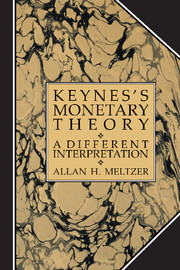Book contents
- Frontmatter
- Contents
- Preface
- 1 Introduction
- 2 Keynes in the 1920s: ideas, beliefs, and events
- 3 Theories, implications, and conjectures in the 1920s
- 4 The General Theory: a different perspective
- 5 Monetary reform and international economic order
- 6 Other interpretations of the General Theory
- 7 Conclusion
- References
- Index
6 - Other interpretations of the General Theory
Published online by Cambridge University Press: 05 September 2009
- Frontmatter
- Contents
- Preface
- 1 Introduction
- 2 Keynes in the 1920s: ideas, beliefs, and events
- 3 Theories, implications, and conjectures in the 1920s
- 4 The General Theory: a different perspective
- 5 Monetary reform and international economic order
- 6 Other interpretations of the General Theory
- 7 Conclusion
- References
- Index
Summary
Five decades after its publication, the General Theory continues to arouse controversy about both its main message and its central hypotheses. Since many of the interpretations are firmly held by their expositors, the book remains subject to differing interpretations. The parties to these disputes often seem more interested in trading verbal blows than in resolving differences, so the differences remain. It does not seem likely that one interpretation is likely to emerge as the sole correct interpretation.
Much of the problem lies with Keynes. Readers as sympathetic as Seymour Harris long ago recognized that the book is difficult to read (Harris 1953, p. x). The same complaint has been made by others, for example, Johnson (1961, in Wood 2, p. 287) and Salant (1985, p. 1184). Keynes, the much praised stylist and maker of memorable phrases, was at his best when writing tracts like the Economic Consequences of the Peace, where precise analytic statements are less important for the reader's understanding of the main message than in the Treatise or the General Theory. Indeed, some of the difficulties of the latter book may arise from Keynes's attempt to use A. C. Pigou or classical economics as foils, much as he had used Clernenceau and Wilson in the Economic Consequences of the Peace, with the result that the criticisms of classical economics obscure both the central message and the close relation to his earlier work that seemed clear to Keynes (7, pp. xxi–xxii).
- Type
- Chapter
- Information
- Keynes's Monetary TheoryA Different Interpretation, pp. 249 - 302Publisher: Cambridge University PressPrint publication year: 1989

